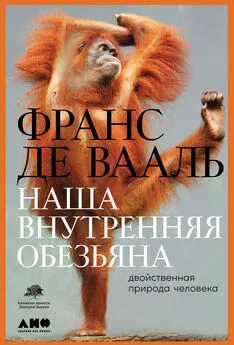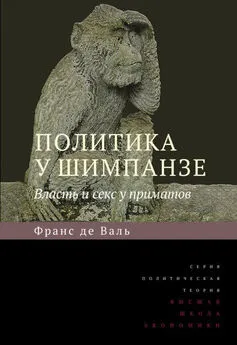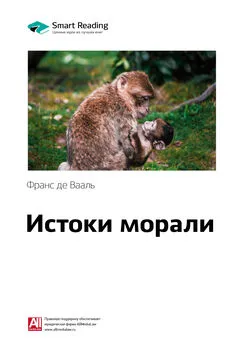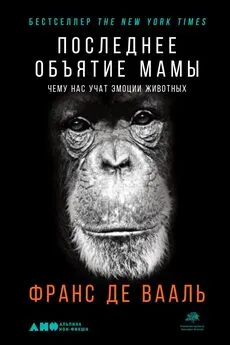Франс Вааль - Наша внутренняя обезьяна. Двойственная природа человека
- Название:Наша внутренняя обезьяна. Двойственная природа человека
- Автор:
- Жанр:
- Издательство:Литагент Альпина
- Год:2021
- Город:Москва
- ISBN:9785001394907
- Рейтинг:
- Избранное:Добавить в избранное
-
Отзывы:
-
Ваша оценка:
Франс Вааль - Наша внутренняя обезьяна. Двойственная природа человека краткое содержание
Де Вааль рассматривает четыре ключевые стороны нашей природы – стремление к власти, потребность в сексе, склонность к актам насилия и проявлениям доброты – и на основании многолетних наблюдений за человекообразными обезьянами доказывает, что все это в полной мере характерно и для них.
В своей работе он приводит аргументы в пользу представления о человеке как о социальном животном, «биполярной обезьяне», равно похожей на агрессивных, склонных к конкуренции шимпанзе и эмпатичных гедонистов-бонобо. Не игнорируя низменные стороны человеческой природы, де Вааль уделяет особое внимание ее положительным, нравственным проявлениям и тому, как две эти стороны сочетаются и дополняют друг друга, будучи одинаково важными для эволюции нашего вида и для выживания цивилизации в целом.
Наша внутренняя обезьяна. Двойственная природа человека - читать онлайн бесплатно ознакомительный отрывок
Интервал:
Закладка:
Simmons, L. W., Firman, R., Rhodes, G., and Peters. M. (2004) “Human Sperm Competition: Testis Size, Sperm Production and Rates of Extrapair Copulations.” Animal Behaviour 68: 297–302.
Singh, D. (1993) “Adaptive Significance of Female Physical Attractiveness: Role of Waist-to-Hip Ratio.” Journal of Personality and Social Psychology 65: 293–307.
Small, M. F. (1995) What’s Love Got to Do with It? New York: Anchor Books.
_____. (2003) “How Many Fathers are Best for a Child?” Discover April: 54–61.
Smuts, B. B. (1995) “The Evolutionary Origins of Patriarchy.” Human Nature 6: 1–32.
Sommer, V. (1994) “Infanticide Among the Langurs of Jodhpur: Testing the Sexual Selection Hypothesis with a Long-Term Record.” In Infanticide and Parental Care , Parmigiani, S., and vom Saal, F. S. (Eds.), pp. 155–187. Chur: Harwood Academic Publishers.
Stanford, C. B. (1999) The Hunting Apes: Meat-eating and the Origins of Human Behavior . Princeton, NJ: Princeton University Press.
Sugiyama, Y. (1967) “Social Organization of Hanuman Langurs.” In Social Communication Among Primates , Altmann, S. A. (Ed.), pp. 221–253. Chicago: The University of Chicago Press.
Suzuki, A. (1971) “Carnivority and Cannibalism Observed Among Forest-Living Chimpanzees.” Journal of the Anthropological Society of Nippon 79: 30–48.
Symons, D. (1979) The Evolution of Human Sexuality . New York: Oxford University Press.
Szalay, F. S., and Costello, R. K. (1991) “Evolution of Permanent Estrus Displays in Hominids.” Journal of Human Evolution 20: 439–464.
Thompson-Handler, N. (1990) The Pygmy Chimpanzee: Sociosexual Behavior, Reproductive Biology and Life History Patterns . Unpublished dissertation, New Haven, CT: Yale University.
Thornhill, R., and Palmer, C. T. (2000) The Natural History of Rape: Biological Bases of Sexual Coercion . Cambridge, MA: MIT Press.
Tratz, E. P., and Heck, H. (1954) “Der Afrikanische Anthropoide ‘Bonobo,’ eine Neue Menschenaffengattung .” Säugetierkundliche Mitteilungen 2: 97–101.
van Hooff, J. A. R. A. M. (2002) De Mens, een Primaat Net Zo “Eigenaardig” als de Andere Primaten . The Hague: Nederlandse Organisatie voor Wetenschappelijk Onderzoek (NWO).
van Schaik, C. P., and Dunbar, R. I. M. (1990) “The Evolution of Monogamy in LargePrimates: A New Hypothesis and Some Crucial Tests.” Behaviour 115: 30–62.
Vasey, P. L. (1995) “Homosexual Behavior in Primates: A Review of Evidence and Theory.” International Journal of Primatology 16: 173–204.
Walker, A. (1998) By the Light of My Father’s Smile . New York: Ballantine.
Wolf, A. P., and Durham, W. H. (2005) Inbreeding, Incest, and the Incest Taboo . Stanford, CA: Stanford University Press.
Wrangham, R. W. (1993) “The Evolution of Sexuality in Chimpanzees and Bonobos.” Human Nature 4: 47–79.
Wright, C. (November 14–21, 2002) “Going Ape.” www.bostonphoenix.com.
Yerkes, R. M. (1941) “Conjugal Contrasts Among Chimpanzees.” Journal of Abnormal and Social Psychology 36: 175–199.
Zerjal, T., et al. (2003) “The Genetic Legacy of the Mongols.” American Journal of Human Genetics 72: 717–721.
Zimmer, C. (2001) Evolution: The Triumph of an Idea . New York: Harper Collins.
Zuk, M. (2002) Sexual Selections: What We Can and Can’t Learn About Sex from Animals . Berkeley, CA: University of California Press.
Atwood, M. E. (1989) Cat’s Eye . New York: Doubleday. Этвуд М. Кошачий глаз. – М.: Эксмо, 2021.
Aureli, F. (1997) “Post-Conflict Anxiety in Nonhuman Primates: The Mediating Role of Emotion in Conflict Resolution.” Aggressive Behavior 23: 315–328.
Aureli, F., and de Waal, F. B. M. (1997) “Inhibition of Social Behavior in Chimpanzees Under High-Density Conditions.” American Journal of Primatology 41: 213–228.
_____. (2000) Natural Conflict Resolution . Berkeley, CA: University of California Press.
Aureli, F., Preston, S. D., and de Waal, F. B. M. (1999) “Heart Rate Responses to Social Interactions in Free-Moving Rhesus Macaques (Macaca Mulatta): A Pilot Study.” Journal of Comparative Psychology 113: 59–65.
Bauman, J. (1926) “Observations of the Strength of the Chimpanzee and its Implications.” Journal of Mammalogy 7: 1–9.
Brewer, S. (1978) The Forest Dwellers . London: Collins.
Butovskaya, M., Verbeek, P., Ljungberg, T., and Lunardini, A. (2001) “A Multi-Cultural View of Peacemaking Among Young Children.” In Natural Conflict Resolution , Aureli, F., and de Waal, F. B. M. (Eds.), pp. 243–258. Berkeley, CA: University of California Press.
Calhoun, J. B. (1962) “Population Density and Social Pathology.” Scientific American 206: 139–148.
Cords, M., and Thurnheer, S. (1993) “Reconciliation with Valuable Partners by Long-Tailed Macaques.” Ethology 93: 315–325.
de Waal, F. B. M. (1986) “Integration of Dominance and Social Bonding in Primates .” Quarterly Review of Biology 61: 459–479.
_____. (1986) “Prügelknaben bei Primaten und eine Tödliche Kampf in der Arnheimer Schimpansenkolonie.” In Ablehnung, Meidung, Ausschluß: Multidisziplinäre Untersuchungen über die Kehrseite der Vergemeinschaftung , Gruter, M., and Rehbinder, M. (Eds.), pp.129–145. Berlin: Duncker & Humblot.
_____. (1989) Peacemaking Among Primates . Cambridge, MA: Harvard University Press.
_____. (1989) “The Myth of a Simple Relation Between Space and Aggression in Captive Primates.” Zoo Biology Supplement 1: 141–148.
_____. (1997) Bonobo: The Forgotten Ape, with photographs by Frans Lanting . Berkeley, CA: University of California Press.
_____. (2000) “Primates – A Natural Heritage of Conflict Resolution.” Science 289: 586–590.
_____. (2001) The Ape and the Sushi Master . New York: Basic Books.
de Waal, F. B. M., and Johanowicz, D. L. (1993) “Modification of Reconciliation Behavior Through Social Experience: An Experiment with Two Macaque Species.” Child Development 64: 897–908.
de Waal, F. B. M., and van Roosmalen, A. (1979) “Reconciliation and Consolation Among Chimpanzees.” Behavioral Ecolology & Sociobiology 5: 55–66.
Ember, C. R. (1978) “Myths About Hunter-Gatherers.” Ethnology 27: 239–448.
Ferguson, B. R. (2002) “The History of War: Fact vs. Fiction.” In Must we Fight? Ury, W. L. (Ed.), pp. 26–37. San Francisco, CA: Jossey-Bass.
_____. (2003) “The Birth of War.” Natural History July/August: 28–34.
Frye, D. P. (2001) “Conflict Management in Cross-Cultural Perspective.” In Natural Conflict Resolution , Aureli, F., and de Waal, F. B. M. (Eds.), pp. 334–351. Berkeley, CA: University of California Press.
Gat, A. (1999) “The Pattern of Fighting in Simple, Small-Scale, Prestate Societies.” Journal of Anthropological Research 55: 563–583.
Gavin, M. (2004) “Primate vs. Primate.” BBC Wildlife January: 50–52.
Goodall, J. (1986) The Chimpanzees of Gombe: Patterns of Behavior . Cambridge, MA: Harvard University Press.
_____. (1999) Reason for Hope . New York: Warner.
Haney, C., Banks, W. C., and Zimbardo, P. G. (1973) “Interpersonal Dynamics in a Simulated Prison.” International Journal of Criminology and Penology 1: 69–97. Hölldobler, B., and Wilson, E. O. (1994) Journey to the Ants. Cambridge, MA: Belknap Press.
Idani, G. (1990) “Relations Between Unit-Groups of Bonobos at Wamba: Encounters and Temporary Fusions.” African Study Monographs 11: 153–186.
Johnson, R. (1972) Aggression in Man and Animals . Philadelphia, PA: Saunders Company.
Judge, P. G., and de Waal, F. B. M. (1993) “Conflict Avoidance Among Rhesus Monkeys: Coping with Short-Term Crowding.” Animal Behaviour 46: 221–232.
Kamenya, S. (2002) “Human Baby Killed by Gombe Chimpanzee.” Pan Africa News 9 (2): 26.
Kano, T. (1992) The Last Ape: Pygmy Chimpanzee Behavior and Ecology . Stanford, CA: Stanford University Press.
Kayumbo, H. Y. (2002) “A Chimpanzee Attacks and Kills a Security Guard in Kigoma.” Pan Africa News 9 (2): 11–12.
Köhler, W. (1959 [1925]) Mentality of Apes . 2nd Edition, New York: Vintage.
Kutsukake, N., and Castles, D. L. (2004) “Reconciliation and Post-Conflict Third-Party Affiliation Among Wild Chimpanzees in the Mahale Mountains, Tanzania.” Primates 45:157–165.
Lagerspetz, K. M., Björkqvist, K., and Peltonen, T. (1988) “Is Indirect Aggression Typical of Females?” Aggressive Behavior 14: 403–414.
Lever, J. (1976) “Sex Differences in the Games Children Play.” Social Problems 23: 478–487.
Lorenz, K. Z. (1966 [1963]) On Aggression . London: Methuen.
Lux, K. (1990) Adam Smith’s Mistake . Boston: Shambhala.
Maestripieri, D., Schino, G., Aureli, F., and Troisi, A. (1992) “A Modest Proposal: Displacement Activities as Indicators of Emotions in Primates.” Animal Behaviour 44: 967–979.
Murphy, D. E., and Halbfinger, D. M. (June 16, 2002) “9/11 Aftermath Bridged Racial Divide, New Yorkers Say, Gingerly.” New York Times , p. 21.
Nishida, T., Hiraiwa-Hasegawa, M., Hasegawa, T., and Takahata, Y. (1985) “Group Extinction and Female Transfer in Wild Chimpanzees in the Mahale Mountains National Park, Tanzania.” Zeitschrift für Tierpsychologie 67: 274–285.
Palagi, E., Paoli, T., and Tarli, S. B. (2004) “Reconciliation and Consolation in Captive Bonobos ( Pan Paniscus ).” American Journal of Primatology 62: 15–30.
Power, M. (1991) The Egalitarians: Human and Chimpanzee . Cambridge: Cambridge University Press.
Preuschoft, S., Wang, X., Aureli, F., and de Waal, F. B. M. (2002) “Reconciliation in Captive Chimpanzees: A Reevaluation with Controlled Methods.” International Journal of Primatology 23: 29–50.
Rabbie, J. M., and Horwitz, M. (1969) “The Arousal of Ingroup-Outgroup Bias by a Chance of Win or Loss.” Journal of Personality and Social Psychology 69: 223–228.
Robarchek, C. A. (1979) “Conflict, Emotion, and Abreaction: Resolution of Conflict Among the Semai Senoi.” Ethos 7: 104–123.
Rubin, L. B. (1985) Just Friends . New York: Harper and Row.
Sapolsky, R. M. (1993) “Endocrinology Alfresco: Psychoendocrine Studies of Wild Baboons.” Recent Progress in Hormone Research 48: 437–462.
Sapolsky, R. M., and Share, L. J. (2004) “A Pacific Culture Among Wild Baboons: Its Emergence and Transmission.” Public Library of Science Biology 2: 534–541.
Schneirla, T. C. (1944) “A Unique Case of Circular Milling in Ants, Considered in Relation to Trail Following and the General Problem of Orientation.” American Museum Novitates 1253: 1–26.
Stanford, C. B. (1999) The Hunting Apes: Meat-Eating and the Origins of Human Behavior . Princeton, NJ: Princeton University Press.
Tannen, D. (1990) You Just Don’t Understand: Women and Men in Conversation . New York: Ballantine.
Taylor, S. (2002) The Tending Instinct . New York: Times Books.
Читать дальшеИнтервал:
Закладка:




![Франс Вааль - Последнее объятие Мамы [litres]](/books/1075030/frans-vaal-poslednee-obyatie-mamy-litres.webp)





